Germany
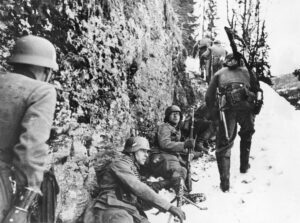 During the largely unsuccessful Norwegian Campaign of World War II, the Allies were in a fight to stop the Germans from fully occupying Norway, but it didn’t work in the end. The Norwegian campaign was carried out from April 8, 1940 to June 10, 1940, and involved the attempt by Allied forces to defend northern Norway coupled with the resistance of the Norwegian military to the country’s invasion by Nazi Germany.
During the largely unsuccessful Norwegian Campaign of World War II, the Allies were in a fight to stop the Germans from fully occupying Norway, but it didn’t work in the end. The Norwegian campaign was carried out from April 8, 1940 to June 10, 1940, and involved the attempt by Allied forces to defend northern Norway coupled with the resistance of the Norwegian military to the country’s invasion by Nazi Germany.
The Norwegian Campaign was planned as Operation Wilfred and Plan R 4, prior to the actual German attack, which the Allies knew was imminent, but had not yet happened. On April 4th, the battlecruiser HMS Renown set out from Scapa Flow for the Vestfjorden with twelve destroyers. The Royal Navy and the  Kriegsmarine met at the First Battle of Narvik on April 9 – 10. The British forces conducted the Åndalsnes landings on April 13, thereby putting everything in place for the actual operation. Germany’s strategic reason for wanting Norway was to seize the port of Narvik and guarantee the delivery of iron ore needed for German steel production. In any war, steel is necessary for much of the weaponry.
Kriegsmarine met at the First Battle of Narvik on April 9 – 10. The British forces conducted the Åndalsnes landings on April 13, thereby putting everything in place for the actual operation. Germany’s strategic reason for wanting Norway was to seize the port of Narvik and guarantee the delivery of iron ore needed for German steel production. In any war, steel is necessary for much of the weaponry.
During one part of that campaign, in an air fight over Norway, a British fighter took down a German plane over a densely wooded area. Unfortunately, the British aircraft crashed as well. As it turns out, both crews survived the crashes, and while trying to get to a safe place, they encountered each other in the wilderness. In most situations, this could have been bad for one or both of the crews, but even though they were struggling against a language barrier, the rival airmen agreed not to turn on each other and instead, to team up in order to find  safety. They stayed in an abandoned hotel and shared breakfast. It wasn’t peace exactly, but they formed an uneasy truce, while they waited to see which side would show up to help first.
safety. They stayed in an abandoned hotel and shared breakfast. It wasn’t peace exactly, but they formed an uneasy truce, while they waited to see which side would show up to help first.
Instead of the British or the Germans, it was a Norwegian ski patrol that showed up to rescue the British soldiers, and of course, to take the Germans as POWs. While that one battle seemed to indicate that the British were headed for a victory over the Germans, that was not to be the case. The Germans did finally take over Norway in its entirety. Of course, as we all know, one battle is not a very good indication of who will win the war, and in the end, it was Germany that took a great fall, losing the entirety of World War II.

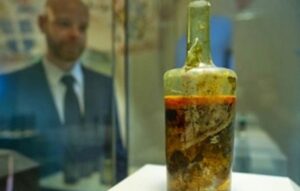 Most people know that wine gets better with age, but I wonder if there is a limit to that statement. Some wines, I’m told wine can be aged for 10 to 20 years, but there really is a limit. In a Roman tomb in Germany in 1867, a bottle of wine was found that is believed to date back to 325 – 350 CE. The oldest bottle of wine ever found. Those who found it, named it Speyer, for the city of Speyer, near where the bottle was found. The bottle was discovered during an excavation of a 4th-century AD Roman nobleman’s tomb. The tomb contained two sarcophagi, one holding the body of a man and one a woman. It was a very unique bottle, with dolphin-shaped handles, and it is sealed with wax and olive oil. I’m sure that was the hope that by so preserving the wine, that it would be able to be used later, but then it was found in a tomb, so I’m not sure of the actual purpose. There were several other bottles found with the Speyer bottle, but they were all empty or broken.
Most people know that wine gets better with age, but I wonder if there is a limit to that statement. Some wines, I’m told wine can be aged for 10 to 20 years, but there really is a limit. In a Roman tomb in Germany in 1867, a bottle of wine was found that is believed to date back to 325 – 350 CE. The oldest bottle of wine ever found. Those who found it, named it Speyer, for the city of Speyer, near where the bottle was found. The bottle was discovered during an excavation of a 4th-century AD Roman nobleman’s tomb. The tomb contained two sarcophagi, one holding the body of a man and one a woman. It was a very unique bottle, with dolphin-shaped handles, and it is sealed with wax and olive oil. I’m sure that was the hope that by so preserving the wine, that it would be able to be used later, but then it was found in a tomb, so I’m not sure of the actual purpose. There were several other bottles found with the Speyer bottle, but they were all empty or broken.
Of course, given the age of the bottles, no one will ever drink the contents. It would not be safe, so the exact contents remain unknown. Nevertheless, archaeologists believe the liquid inside was made from grapes planted in the region. The Speyer wine bottle (Römerwein in German) is a sealed bottle that is will not been opened to check the contents. Even without verification, it is considered the world’s oldest known bottle of wine. Since the discovery of the bottle, it has been exhibited at the Wine Museum section of the Historical Museum of the Palatinate in Speyer. The “Römerwein” is housed in the museum’s Tower Room. It is a 51 US fluid ounce glass bottle with amphora-like “shoulders” that are yellow green in color and with dolphin-shaped handles.
It is thought that the man in the tomb was a Roman legionary, and the wine was a provision for his journey to  Heaven. People had some strange customs back then, and some may still have. Of the six glass bottles in the woman’s sarcophagus and the ten vessels in the man’s sarcophagus, only one still contained a liquid. There is a clear liquid in the bottom third, and a mixture similar to rosin above. While it has reportedly lost its ethanol content, analysis is consistent with at least part of the liquid having been wine, although I’m not sure how they made that analysis without opening the bottle. The wine was infused with a mixture of herbs, but the preservation of the wine is attributed to the large amount of thick olive oil. Since I’m not a scientist, I’m not sure how that would work, but apparently it did, as it was added to the bottle to seal the wine off from air, along with a hot wax seal. The use of glass in the bottle is unusual, however, as typically Roman glass was too fragile to be dependable over time.
Heaven. People had some strange customs back then, and some may still have. Of the six glass bottles in the woman’s sarcophagus and the ten vessels in the man’s sarcophagus, only one still contained a liquid. There is a clear liquid in the bottom third, and a mixture similar to rosin above. While it has reportedly lost its ethanol content, analysis is consistent with at least part of the liquid having been wine, although I’m not sure how they made that analysis without opening the bottle. The wine was infused with a mixture of herbs, but the preservation of the wine is attributed to the large amount of thick olive oil. Since I’m not a scientist, I’m not sure how that would work, but apparently it did, as it was added to the bottle to seal the wine off from air, along with a hot wax seal. The use of glass in the bottle is unusual, however, as typically Roman glass was too fragile to be dependable over time.
Scientists have considered opening the bottle to further analyze the contents, but as of 2023 the bottle has remained unopened, mostly because of concerns about how the liquid would react when exposed to air. The museum’s curator, Ludger Tekampe has stated he has seen no changes in the bottle in over 25 years, so whatever they are doing to preserve it is working. It seems to me that scientists would be remiss in their care of this bottle by opening it for no good reason. I think it should be left as is.

 World War I was a different era, even in the way war was conducted. Oh, war is still war, and there is wounding, bombing, killing, and capturing. Nevertheless, with one leader, Kaiser Wilhelm II, there was also compassion. After being captured and placed in a POW camp, a British officer, Captain Robert Campbell found out that his mother was dying. He couldn’t bear the thought of not seeing his mother before she passed away, and in his grief, he took a chance. He appealed to Kaiser Wilhelm II, asking to be allowed to go home to visit his mother before she died. Amazingly, Kaiser Wilhelm II granted his request, on the condition that he return to the POW camp after the visit.
World War I was a different era, even in the way war was conducted. Oh, war is still war, and there is wounding, bombing, killing, and capturing. Nevertheless, with one leader, Kaiser Wilhelm II, there was also compassion. After being captured and placed in a POW camp, a British officer, Captain Robert Campbell found out that his mother was dying. He couldn’t bear the thought of not seeing his mother before she passed away, and in his grief, he took a chance. He appealed to Kaiser Wilhelm II, asking to be allowed to go home to visit his mother before she died. Amazingly, Kaiser Wilhelm II granted his request, on the condition that he return to the POW camp after the visit.
When you think about it, once he was safely home with his mother, Captain Campbell could have simply stayed. Seriously, what could the Kaiser have done about it. Nevertheless, being an honorable man, Captain Campbell kept his promise to Kaiser Wilhelm II and returned from Kent to Germany after visiting his mother for a week. He stayed at the camp until the war ended in 1918. That was not the end of the story, however.
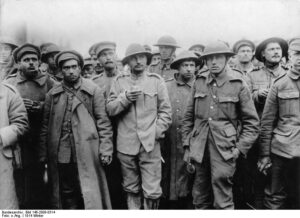
On August 24, 1914, then 29-year-old Captain Campbell, of the 1st Battalion East Surrey Regiment, was captured in northern France. He was sent to a prisoner-of-war (POW) camp in Magdeburg, north-east Germany. It was there that he received the heartbreaking news that his mother, Louise was dying of cancer. Captain Campbell traveled through the Netherlands and then by boat and train to Gravesend in Kent, where he spent a week with his mother before returning to Germany the same way. His mother died in February 1917.
With the kindness of the Kaiser, and a duty to honor his word, Captain Campbell, knowing that if he didn’t return, no one else would ever be given that same consideration, Captain Campbell returned to Germany. Strangely, there was no issues during his return. I suppose the Kaiser could have cleared the way previously, but it would be my guess that the Kaiser was just as shocked by the return as I am. Unfortunately, Britain wasn’t as considerate, because they blocked a similar request from German prisoner Peter Gastreich, who was being held at an internment camp on the Isle of Man. After that no other British prisoners of war were afforded compassionate leave.
As for Captain Campbell, while he felt duty-bound to return to captivity, he did not feel duty-bound to stay in 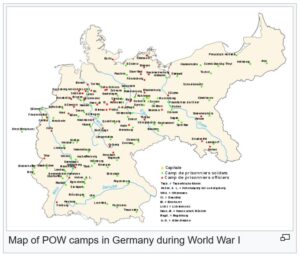
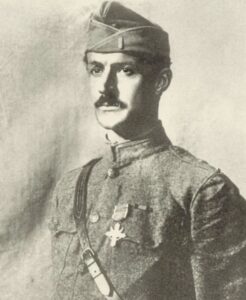 captivity. As soon as Captain Campbell returned to the camp, he set about trying to escape. He and a group of other prisoners spent nine months digging their way out of the camp before being captured on the Dutch border and sent back. He remained in the camp until 1918 and served in the military until 1925. Captain Campbell rejoined the military when World War II broke out in 1939 and served as the chief observer of the Royal Observer Corps on the Isle of Wight. He died in the Isle of Wight in July 1966, aged 81.
captivity. As soon as Captain Campbell returned to the camp, he set about trying to escape. He and a group of other prisoners spent nine months digging their way out of the camp before being captured on the Dutch border and sent back. He remained in the camp until 1918 and served in the military until 1925. Captain Campbell rejoined the military when World War II broke out in 1939 and served as the chief observer of the Royal Observer Corps on the Isle of Wight. He died in the Isle of Wight in July 1966, aged 81.
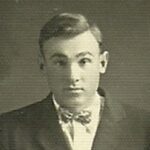
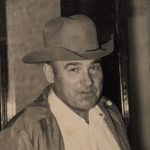 My husband’s grandfather, Andrew Carl Schulenberg was an interesting character. Born on March 12, 1906, to Max Heinrich Johann Carl Schulenberg and Julia Marie Doll. His dad was born in Oldenburg, Lower Saxony, Germany, and in those days, children were often given multiple middle names. I have always found that to be of interest, as I used to think that pretty much only royal children were given multiple middle names. It actually isn’t all that uncommon and many children today have multiple middle names. Max had immigrated to America by the time he met Julia, and they were married in Blair, Nebraska. Their oldest son, Andrew was born in Herman, Nebraska, as were his sisters Anna and Claudine. The rest of Andrew’s nine siblings were born in Forsyth, Montana.
My husband’s grandfather, Andrew Carl Schulenberg was an interesting character. Born on March 12, 1906, to Max Heinrich Johann Carl Schulenberg and Julia Marie Doll. His dad was born in Oldenburg, Lower Saxony, Germany, and in those days, children were often given multiple middle names. I have always found that to be of interest, as I used to think that pretty much only royal children were given multiple middle names. It actually isn’t all that uncommon and many children today have multiple middle names. Max had immigrated to America by the time he met Julia, and they were married in Blair, Nebraska. Their oldest son, Andrew was born in Herman, Nebraska, as were his sisters Anna and Claudine. The rest of Andrew’s nine siblings were born in Forsyth, Montana.
After a hunting accident took his right leg, Andy had a true peg leg for the rest of his life. Maybe it was the fact that he was only in his teens when it happened, or maybe it was just his own determined personality, but Andy did not let a “little thing” like an amputated leg turn him into an invalid. He went forward with his life…after about a year in the hospital, that is. And while he really didn’t like guns much after that, he was still capable of using one if needed. And actually, went on to become the sheriff of Rosebud County, Montana, and did it without a gun. I suppose it might have seemed a little bit like Sheriff Andy Taylor on the Andy Griffith Show, but I can’t say that Forsyth, or Rosebud County, was a tame as Mayberry was. Andy took it all in stride, worked with multiple agencies over his years as sheriff, and handled the Indian nation with mutual respect and grace. That was the reason they worked so well with him.
I first met Andy at a family reunion when my girls were about 6 and 5 years old. He was, of course their great 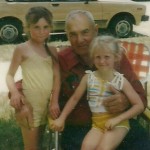
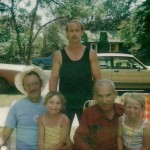 grandfather. And he seemed bigger than life. He was a tall…very tall man, but then I’m short, and maybe not a good judge of height. Still, I would guess 6 foot 3 inches, at last. His son, Uncle Butch Schulenberg could probably tell me for sure. Nevertheless, as big as he was, he took the time to build two small chairs for my girls, chairs they still love to this day. He was excited to meet them, and they were excited to meet him. I will always be glad we had that time with him. Today is the 117th anniversary of Grandpa Andy Schulenberg’s birth. Happy birthday in Heaven, Grandpa. We love and miss you very much.
grandfather. And he seemed bigger than life. He was a tall…very tall man, but then I’m short, and maybe not a good judge of height. Still, I would guess 6 foot 3 inches, at last. His son, Uncle Butch Schulenberg could probably tell me for sure. Nevertheless, as big as he was, he took the time to build two small chairs for my girls, chairs they still love to this day. He was excited to meet them, and they were excited to meet him. I will always be glad we had that time with him. Today is the 117th anniversary of Grandpa Andy Schulenberg’s birth. Happy birthday in Heaven, Grandpa. We love and miss you very much.
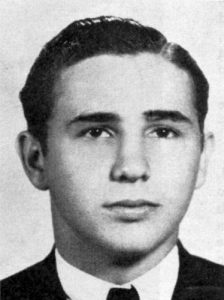
 Once upon a time, journalists and the media as a whole had an obligation to tell the truth, or at least tell the public that the story was their opinion only. The had to have reliable sources, even if they didn’t have to disclose them. While they weren’t “forced” to be truthful, they were completely shunned if they didn’t.
Once upon a time, journalists and the media as a whole had an obligation to tell the truth, or at least tell the public that the story was their opinion only. The had to have reliable sources, even if they didn’t have to disclose them. While they weren’t “forced” to be truthful, they were completely shunned if they didn’t.
When a journalist is mesmerized by someone, they can definitely fall hard for them. Such was the case with “the job-creating Führer with eyes that were like ‘blue larkspur.'” Why did so many journalists spend years dismissing the evidence of Hitler’s atrocities? Some, like the Christian Science Monitor called Hiter’s effect on Germany as providing “a dark land a clear light of hope.” They talked about how smoothly things were running, how well regulated everything was, and how great the police uniforms were. Strangely, when it came to the killing of the Jewish people, they said things like, “I have so far found quietness, order, and civility;” there was “not the slightest sign of anything unusual afoot.” As for all those “harrowing stories” of Jews being mistreated…they seemed to apply “only to a small proportion;” most were “not in any way molested.” They made it seem like as long as the number were “low,” the problem couldn’t possibly be a big one. Well, the reality as we all know now is that the “problem” was enormous, heinous, and horrific beyond imagination.
Trusting the journalists implicitly, without doing your own research is a very dangerous plan. Journalists have been known to assist in “hiding the evidence” in a matter…as we have seen in recent years. I don’t believe that all journalists are “bad” people, but those that are “bad” people ruin the reputation of journalism for every good journalist. I’m not even sure I would call some of the media, journalists. They are truly just “bad fiction writers,” in my opinion. Anyone who covers up the truth in the name of free speech or forces others to hide the truth in the name of tolerance is a bad journalist.
Many in the American mainstream newspaper industry portrayed the Hitler regime positively, especially in its 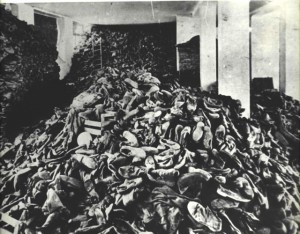
 early months. Looking back now, we wonder how they could have said the good things they said about such a horrible dictator. The media published warm human-interest stories about Hitler, while simply excusing or rationalizing Nazi anti-Semitism. These actions should haunt the conscience of United States Journalism to this day. There was no excuse for what Hitler did, and to write it off as “not so bad” was absolutely inexcusable.
early months. Looking back now, we wonder how they could have said the good things they said about such a horrible dictator. The media published warm human-interest stories about Hitler, while simply excusing or rationalizing Nazi anti-Semitism. These actions should haunt the conscience of United States Journalism to this day. There was no excuse for what Hitler did, and to write it off as “not so bad” was absolutely inexcusable.
Of course, not all of the “bad journalism” of the day was sinister. Hitler was an unfamiliar subject when he first appeared on the international scene. His ideals and his movement were unknown, and so could have been mistaken for something quite innocent…at first. The Nazis had risen from barely 18 percent of the national vote in mid-1930 to become Germany’s largest party only two years later and gained power just months after that. I suppose that the political rise of Hitler could have just seemed like someone with great ideas stepping up to the microphone. It is thought that many American editors and reporters erroneously assumed, based on previous experience, that a radical candidate would show some restraint once in office, but that was not Hitler’s plan. He planned to take over the world…to become a One World Government. Really, any time anyone tries to take away the sovereignty of a country, they are not acting in the best interest of that country. That is something we must never forget.
An editorial in the Philadelphia Evening Bulletin on January 30, 1933, asserted that “there have been indications of moderation” on Hitler’s part. The editors of The Cleveland Press, on January 31, 1933, claimed the 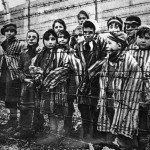
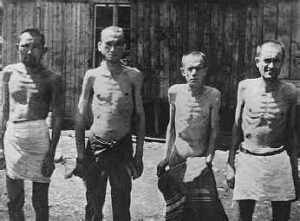 “appointment of Hitler as German chancellor may not be such a threat to world peace as it appears at first blush.” Frederick Birchall, Berlin bureau chief for The New York Times, found “a new moderation” in the political atmosphere following Hitler’s rise to power. Unfortunately, all of them were dead wrong!! Hitler was not a moderate. He was, in fact, more of a threat than they could ever have imagined. Hitler was the epitome of evil, and like it or not, any journalist who softened the story, was guilty of hiding the evidence.
“appointment of Hitler as German chancellor may not be such a threat to world peace as it appears at first blush.” Frederick Birchall, Berlin bureau chief for The New York Times, found “a new moderation” in the political atmosphere following Hitler’s rise to power. Unfortunately, all of them were dead wrong!! Hitler was not a moderate. He was, in fact, more of a threat than they could ever have imagined. Hitler was the epitome of evil, and like it or not, any journalist who softened the story, was guilty of hiding the evidence.
 We have come to expect apartment buildings to look pretty much the same. There might be a few structural differences, but basically the idea is small homes stacked on top of each other, so that multiple families can be housed is a relatively small space. These days I have seen more buildings that look almost like very large houses, mansions even, but the reality is that they buildings house many families, and the apartments are rather cookie-cutter and plain.
We have come to expect apartment buildings to look pretty much the same. There might be a few structural differences, but basically the idea is small homes stacked on top of each other, so that multiple families can be housed is a relatively small space. These days I have seen more buildings that look almost like very large houses, mansions even, but the reality is that they buildings house many families, and the apartments are rather cookie-cutter and plain.
One building…the Waldspirale, which means forest spiral in English, is not just another random residential building. Designed by Friedensreich 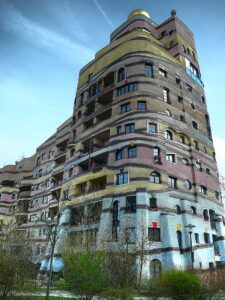 Hundertwasser, this architectural wonder located in Darmstadt in Germany. Construction began at the end of 1990s and was completed in 2000. This building is no ordinary structure. The U-shape of the building is characterized by unique multicolored facade and lack of straight lines. The plan was to make sure that no other building looked quite like this one. The inside of the building is just as unique as the outside. The inner wall corners are rounded to match the outer walls of the building. The building has 105 apartments, a garage, and a playground for children…with a tiny artificial lake…much more than the average apartment building in the 90s. The building is really irregularly shaped, and while it seems short, the highest point of the building goes up to the 12th floor. That is all interesting, but what I find the most interesting is that not one of the 1000 windows in the building are the same and the handles on the doors are also different. Imagine just finding 1000 different windows and probably as many different doors too.
Hundertwasser, this architectural wonder located in Darmstadt in Germany. Construction began at the end of 1990s and was completed in 2000. This building is no ordinary structure. The U-shape of the building is characterized by unique multicolored facade and lack of straight lines. The plan was to make sure that no other building looked quite like this one. The inside of the building is just as unique as the outside. The inner wall corners are rounded to match the outer walls of the building. The building has 105 apartments, a garage, and a playground for children…with a tiny artificial lake…much more than the average apartment building in the 90s. The building is really irregularly shaped, and while it seems short, the highest point of the building goes up to the 12th floor. That is all interesting, but what I find the most interesting is that not one of the 1000 windows in the building are the same and the handles on the doors are also different. Imagine just finding 1000 different windows and probably as many different doors too.
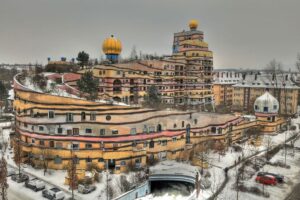 While it was designed by Austrian artist Friedensreich Hundertwasser, it was planned and implemented by architect Heinz M Springmann and constructed by the Bauverein Darmstadt company. I’m sure the uniqueness of the building, while somewhat simple to design, would take a lot of planning and the structure would take some special planning to make it stable enough to carry out the structure as it was designed the uniqueness of the plan. Since I, like many other people have watched the DIY channels, I know that the more unique the structure the more work goes into making it stable. While some people might consider it weird to live in such a building, I think it might be kind of fun.
While it was designed by Austrian artist Friedensreich Hundertwasser, it was planned and implemented by architect Heinz M Springmann and constructed by the Bauverein Darmstadt company. I’m sure the uniqueness of the building, while somewhat simple to design, would take a lot of planning and the structure would take some special planning to make it stable enough to carry out the structure as it was designed the uniqueness of the plan. Since I, like many other people have watched the DIY channels, I know that the more unique the structure the more work goes into making it stable. While some people might consider it weird to live in such a building, I think it might be kind of fun.

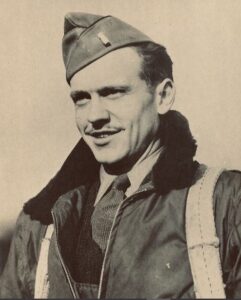 Because my dad, Allen Spencer was the flight engineer and top turret gunner on a B-17G in World War II, the B-17 has always held my interest. The plane was practically indestructible because of its great flying characteristics, resistance to combat damage, and fierce defensive firepower. Built by Boeing, it was called the B-17 Flying Fortress and it was the backbone of the American bomber force in Europe. In the European Theater of World War II (1939-1945), “one of the most dangerous occupations for Allied soldiers, sailors, or airmen was the flying of strategic bombers.” That was a statement that surprised me a little, because I would have expected the men on the ground to be in far more danger. I knew that there was a time my dad had to hang out of the open bomb bay doors to crank the landing gear down when they were damaged in combat, and I vaguely recall that they lost a ball turret gunner when he was wounded in battle and, while they pulled him out to render aid, they couldn’t save him.
Because my dad, Allen Spencer was the flight engineer and top turret gunner on a B-17G in World War II, the B-17 has always held my interest. The plane was practically indestructible because of its great flying characteristics, resistance to combat damage, and fierce defensive firepower. Built by Boeing, it was called the B-17 Flying Fortress and it was the backbone of the American bomber force in Europe. In the European Theater of World War II (1939-1945), “one of the most dangerous occupations for Allied soldiers, sailors, or airmen was the flying of strategic bombers.” That was a statement that surprised me a little, because I would have expected the men on the ground to be in far more danger. I knew that there was a time my dad had to hang out of the open bomb bay doors to crank the landing gear down when they were damaged in combat, and I vaguely recall that they lost a ball turret gunner when he was wounded in battle and, while they pulled him out to render aid, they couldn’t save him.
What I didn’t know about was something that happened on January 1, 1945, that was so bizarre that it seems like a ‘tall tale’ more than an actual event. Nevertheless, it was an actual event, and it was shocking. On that day, the Flying Fortress and the men who flew them were going to be tested beyond any limits they could have imagined, and beyond anything they were trained for. During a chaotic battle complete with ferocious anti-aircraft gunfire (flak) and enemy fighters, two B-17 Bombers managed to collide. A B-17, number 43-338457, piloted by 1st Lieutenant William G MacNab and 2nd Lieutenant Nelson B Vaughn, had risen upward. The top turret guns on MacNab’s plane had pierced through the aluminum skin on the bottom of 1st Lieutenant Glenn H Rojohn’s B-17, number 42-231987, binding the two huge planes together, as Rojohn’s co-pilot 2nd Lieutenant William G Leek, Jr said, like ‘breeding dragonflies.’ The two planes had become one. Upon impact, instead of exploding or breaking into pieces, the colliding planes became stuck together in a piggyback fashion, one atop the other. I’m sure that the men in the top plane, at least were in shock at this strange turn of affairs. I say the top plane, because it is thought that the men in the bottom plane were incapacitated or dead. There was no communication with them. Once the men realized that they weren’t going to crash, they would have to figure out their next move.
Even more shocked than the crew of the B-17 were the German fighter pilots who suddenly saw the whole confusing, but disastrous event. People just don’t expect that a mid-air collision could result in two planes stuck together. For the German fighter pilots, however, the situation took on an even more bizarre tone, because they honestly thought that the US must have created some sort of new secret weapon!! For the men onboard, the situation was dire. I’m sure they expected the explosion to come at any moment, so some of the airmen bailed out. The pilot of the top bomber, Rojohn tried, but was unable to separate the aircraft. Strangely, he was able to control the flight of the ‘hybrid dual-bomber’ somehow, despite turning his own engines off. The lower plane’s engines were still running, because its propellers were still turning. There was no communication with the crew of the bottom plane, which is why it was assumed that they were either incapacitated or already dead.
In a valiant effort, Rojohn decided to try to land the planes, probably hoping that the other crew could be saved, and complicated by the fact that he and his co-pilot, Leek couldn’t get out anyway. At that point, he might as well do his best to save the two or more of them that he could. He coaxed the joined bombers to a relatively safe landing in Germany at Wilhemshaven. Unfortunately, the lower bomber slid out from under the top bomber upon landing and immediately exploded. While the crew of the lower bomber perished in the landing and subsequent explosion, most of the crew of Rojohn’s B-17 survived and was taken prisoner. While being held in the camps, the German interrogators, who were skeptical of the account of the incident given by 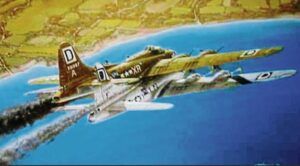
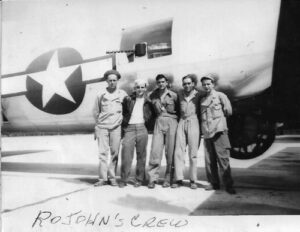 Rojohn, initially were of the opinion the flight represented a new American aerial design. I’m sure they later realized their error, but they must have also realized the resiliency of the B-17 Flying Fortress. Rojohn and his co-pilot, Leek, earned the Distinguished Flying Cross for their feat of aerial skill…a well-deserved award, if you ask me.
Rojohn, initially were of the opinion the flight represented a new American aerial design. I’m sure they later realized their error, but they must have also realized the resiliency of the B-17 Flying Fortress. Rojohn and his co-pilot, Leek, earned the Distinguished Flying Cross for their feat of aerial skill…a well-deserved award, if you ask me.
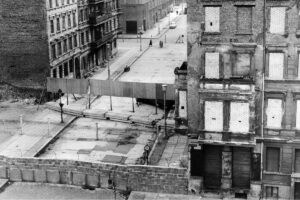
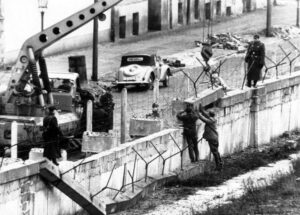 In August of 1961, virtually overnight, the Berlin appeared, separating East and West Berliners from each other. Streets, subway lines, bus lines, tramlines, canals, and rivers were divided. Family members, friends, lovers, schoolmates, work colleagues, and others were abruptly separated. For many, life was put on hold. That meant that families were instantly separated from each other, and there was nothing anyone could do about it. If a child was spending the night with a grandparent, they now had to stay there. If couples were separated, possibly due to jobs or something, they couldn’t get back together. Families who lived on opposite sides of town, couldn’t see each other. No recourse. All the families could do was stand beside the wall and talk to each other.
In August of 1961, virtually overnight, the Berlin appeared, separating East and West Berliners from each other. Streets, subway lines, bus lines, tramlines, canals, and rivers were divided. Family members, friends, lovers, schoolmates, work colleagues, and others were abruptly separated. For many, life was put on hold. That meant that families were instantly separated from each other, and there was nothing anyone could do about it. If a child was spending the night with a grandparent, they now had to stay there. If couples were separated, possibly due to jobs or something, they couldn’t get back together. Families who lived on opposite sides of town, couldn’t see each other. No recourse. All the families could do was stand beside the wall and talk to each other.
From the time of its construction, it was more than two years after before anyone was able to cross from one side of the wall to the other. In the meantime, children grew, children were born, people died. Some children and grandchildren never got to see their parents or grandparents again. The whole purpose of the Berlin Wall was to force the people in East Berlin to accept communism. The only way they “might be able” to stay alive was to comply. So, the citizens of East Berlin became virtual prisoners overnight. Their sentence was long, and they had no trial. They were simply locked up in their own city.
The “sentence” continued for more than two years, before anything changed. Then, finally, on December 20, 1963, nearly 4,000 West Berliners were allowed to cross into East Berlin to visit relatives. It was called a “one-day pass” and didn’t mean the end of the siege. Nevertheless, it was a moment of hope. The day was a result 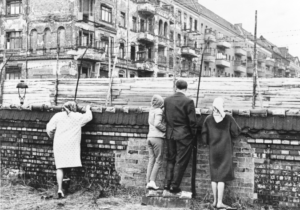
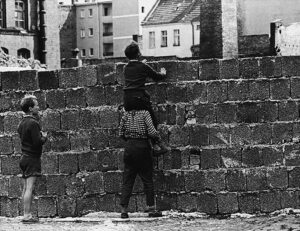 of an agreement reached between East and West Berlin. Eventually, over 170,000 passes were issued to West Berlin citizens, each pass allowing a one-day visit to communist East Berlin. Of course, there would be no passes for East German citizens to visit the west. The government knew they would not come back.
of an agreement reached between East and West Berlin. Eventually, over 170,000 passes were issued to West Berlin citizens, each pass allowing a one-day visit to communist East Berlin. Of course, there would be no passes for East German citizens to visit the west. The government knew they would not come back.
The day was marketed as a “wonderful government” doing some kind of a great thing. There were also moments of poignancy and propaganda. The reunions who were filled with tears, laughter, and other outpourings of emotions as mothers and fathers, sons and daughters finally met again. They were grateful, if only for a short time. The tensions of the Cold War were ever close by.
As people crossed through the checkpoints, loudspeakers in East Berlin greeted them. They were told that they were now in “the capital of the German Democratic Republic,” a political division that most West Germans refused to accept. The propaganda continued as each visitor was given a brochure that explained that the wall was built to “protect our borders against the hostile attacks of the imperialists.” They were told that decadent western culture, including “Western movies” and “gangster stories,” were flooding into East Germany before the wall sealed off such dangerous trends. The picture they were painting was of the East German government being the “saviors of the morality” of the people.
The West Berliners weren’t terribly happy either and many newspapers charged that the visitors charging that they were just pawns of East German government propaganda. It was said that the whole thing was a ploy to 
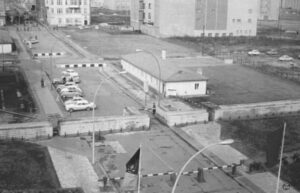 gain West German acceptance of a permanent division of Germany. Whatever the case may be, the visitors felt that they had no choice to comply with the rules, because their hearts were being torn out by these separations. The separation continued until President Reagan called for the wall to be torn down in a speech in West Berlin on June 12, 1987…almost 26 years after it was built.
gain West German acceptance of a permanent division of Germany. Whatever the case may be, the visitors felt that they had no choice to comply with the rules, because their hearts were being torn out by these separations. The separation continued until President Reagan called for the wall to be torn down in a speech in West Berlin on June 12, 1987…almost 26 years after it was built.
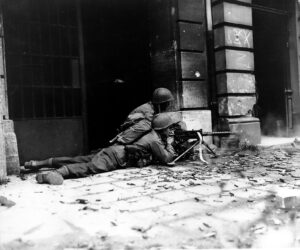
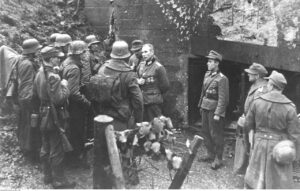 The Nazis were famous for taking no thought for the people around them, as long as they go what they wanted. Achen, Germany was one example of that lack of care and compassion. In October of 1944, the city has been incorporated into the Siegfried Line (known as the Hindenburg Line to the Americans). The Siegfried Line was the main defensive network on Germany’s western border.
The Nazis were famous for taking no thought for the people around them, as long as they go what they wanted. Achen, Germany was one example of that lack of care and compassion. In October of 1944, the city has been incorporated into the Siegfried Line (known as the Hindenburg Line to the Americans). The Siegfried Line was the main defensive network on Germany’s western border.
Fighting around Aachen began as early as the second week of September. It was a period of time known to the Germans as the “First Battle of Aachen.” At that time, the city was defended by the 116th Panzer Division. A panzer division was “a combined arms formation, having both tanks, (German: Panzerkampfwagen, which means armored fighting vehicle, usually shortened to “Panzer”), mechanized and motorized infantry, along with artillery, anti-aircraft and other integrated support elements.” The Panzer Division was under the command of General Gerhard von Schwerin. The proximity of Allied forces made the city officials very nervous, and quickly caused the majority of the city’s government officials to desert their post, long before the evacuation of its citizens was complete. While most of us would be furious over this desertion, Hitler had taken it one step further, by stripping each of the deserting officials of their rank and sending them to the Eastern front as privates. Rather a fitting punishment, but I seriously doubt if Hitler cared about the people. He wanted the officials there for war purposes. Then, in the greatest atrocity, instead of continuing the evacuation, von Schwerin decided to surrender the city to Allied forces. He would have had no idea if the Allies would trat the people kindly or not, but then he really didn’t care. However, on September 13, before he could deliver a letter of capitulation he had written, von Schwerin was ordered to launch a counterattack against American forces penetrating southwest of Aachen. Reluctantly he followed the orders, probably because he fear Hitler more than the Allied forces. He used elements of his panzergrenadier (the motorized infantry) forces. The German general’s Treasonous act when he attempted to surrender the city was irrelevant now, because his letter was never delivered. Unfortunately for him, it fell into the hands of Adolf Hitler, who ordered the general’s immediate arrest. He was replaced by Colonel Gerhard Wilck.
The United States’ VII Corps continued to push German defenses, despite the resistance they encountered on September 12th and 13th. Between September 14 and 16, the US 1st Infantry Division continued its advance in the face of strong defenses and repeated counterattacks, ultimately creating a half-moon arc around the city. Unfortunately, this slow advance came to a halt in late September, due to the supply problem, and the diversion of existing stocks of fuel and ammunition for Operation Market Garden in the Netherlands.
During what would then be known, to the Germans at least, the second Battle of Aachen, American and German forces in and around Aachen, Germany, fought for supremacy between October 2 and 21, 1944. The 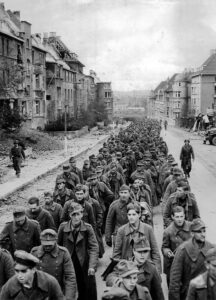
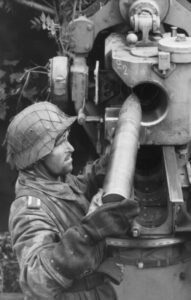 Allies needed the city to advance into the industrialized Ruhr Basin, whether they wanted to fight a battle in the city or not. Although most of Aachen’s civilian population was evacuated before the battle began, much of the city was destroyed and both sides suffered heavy losses. The people would have nothing to come home to. It was one of the largest urban battles fought by US forces in World War II. Aachen was also the first city on German soil to be captured by the Allies. The battle ended with a German surrender, but their tenacious defense significantly disrupted Allied plans for the advance into Germany. The Battle of Aachen had cost both the Americans and Germans dearly; the former suffered over 7,000 casualties, while the latter lost over 5,000 casualties and 5,600 taken prisoner.
Allies needed the city to advance into the industrialized Ruhr Basin, whether they wanted to fight a battle in the city or not. Although most of Aachen’s civilian population was evacuated before the battle began, much of the city was destroyed and both sides suffered heavy losses. The people would have nothing to come home to. It was one of the largest urban battles fought by US forces in World War II. Aachen was also the first city on German soil to be captured by the Allies. The battle ended with a German surrender, but their tenacious defense significantly disrupted Allied plans for the advance into Germany. The Battle of Aachen had cost both the Americans and Germans dearly; the former suffered over 7,000 casualties, while the latter lost over 5,000 casualties and 5,600 taken prisoner.
 Man has always been interested in the stars and planets, even before we really knew what they were. Those mysterious lights in the sky that somehow just showed up every night and disappeared every morning, only to be replaced with the bright sunlight, quickly became a part of our lives from the time we were born. The main thing that has changed over the centuries is the equipment with which we could view space for ourselves.
Man has always been interested in the stars and planets, even before we really knew what they were. Those mysterious lights in the sky that somehow just showed up every night and disappeared every morning, only to be replaced with the bright sunlight, quickly became a part of our lives from the time we were born. The main thing that has changed over the centuries is the equipment with which we could view space for ourselves.
On September 23, 1846, Johann Gottfried Galle, a German astronomer from Radis, Germany, at the Berlin Observatory with the assistance of student Heinrich Louis d’Arrest, was the first person to view the planet Neptune and know what he was looking at. Of course, other astronomers had seen other planets, but this was the first time anyone actually saw the eighth planet in our solar system. Neptune was believed to be out there in that position, as French astronomer Urbain-Jean-Joseph Le Verrier had calculated the approximate location of the planet to be. Le Verrier, by studying gravity-induced disturbances in the  motions of Uranus guessed that another planet was there. He then told Galle of his findings on the 23rd, and the same night Galle and his assistant Heinrich Louis d’Arrest identified Neptune at their observatory in Berlin. Basically, they looked at its movement against a background of stars over 24 hours and that confirmed that it had to be a planet…seeing a place where the stars were blocked by “something” or in this case, Neptune.
motions of Uranus guessed that another planet was there. He then told Galle of his findings on the 23rd, and the same night Galle and his assistant Heinrich Louis d’Arrest identified Neptune at their observatory in Berlin. Basically, they looked at its movement against a background of stars over 24 hours and that confirmed that it had to be a planet…seeing a place where the stars were blocked by “something” or in this case, Neptune.
Neptune is a blue gas giant, which has a diameter four times that of Earth. The astronomers named it after the Roman god of the sea…why do they always use the Greek or in this case Roman gods? Neptune has eight known moons, of which Triton is the largest. It also has a ring system containing three bright and two dim rings. It completes an orbit of the sun once every 165 years. Since Pluto was “deplanetized” in 2006, because it was demoted to dwarf planet, Neptune became the farthest known solar planet. While it may be the furthest out, it  is not the smallest, but rather it’s the fourth-largest planet by diameter, the third-most-massive planet, and the densest giant planet. Neptune’s mass is 17 times the mass of Earth, and slightly more massive than its near-twin Uranus. Neptune is more dense and physically smaller than Uranus, because its greater mass causes more gravitational compression of its atmosphere. It is referred to as one of the solar system’s two ice giant planets
is not the smallest, but rather it’s the fourth-largest planet by diameter, the third-most-massive planet, and the densest giant planet. Neptune’s mass is 17 times the mass of Earth, and slightly more massive than its near-twin Uranus. Neptune is more dense and physically smaller than Uranus, because its greater mass causes more gravitational compression of its atmosphere. It is referred to as one of the solar system’s two ice giant planets
In 1989, the US spacecraft Voyager 2 was the first human spacecraft to actually visit Neptune. Nevertheless, while much more has been learned about the eighth planet, the first person to actually find it was Johann Gottfried Galle, way back in 1846.

